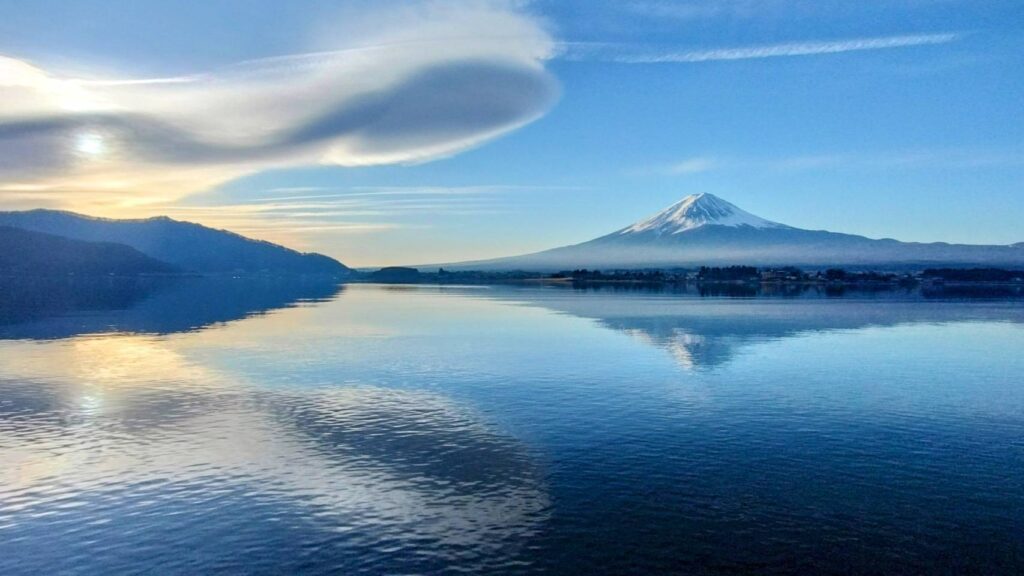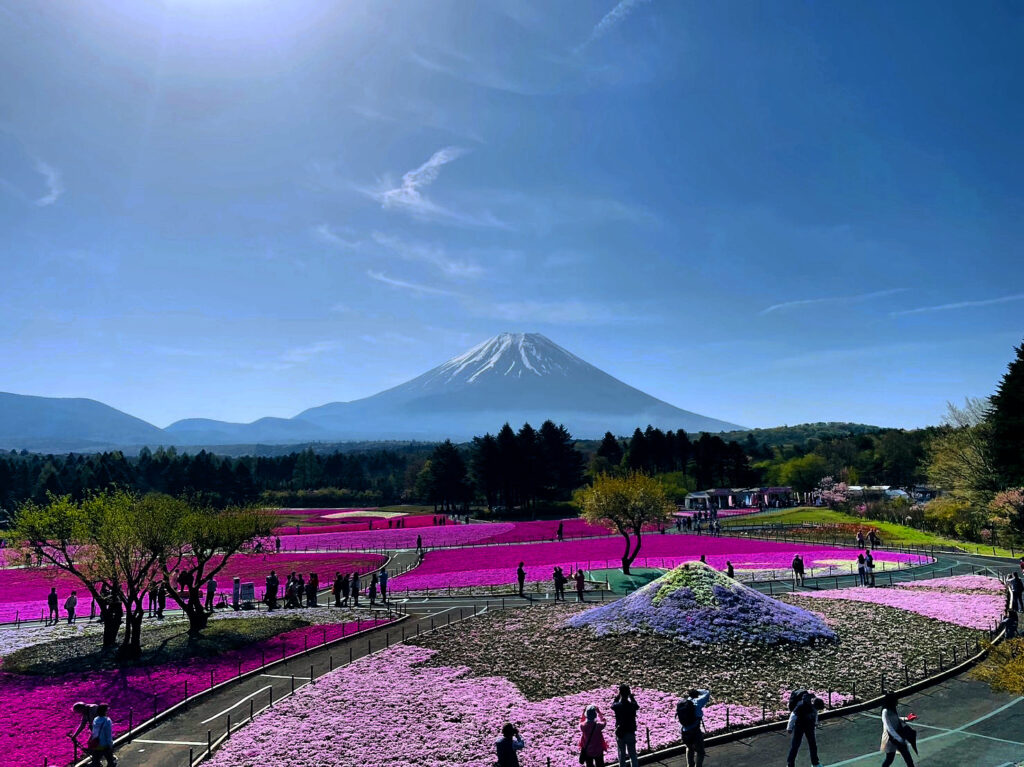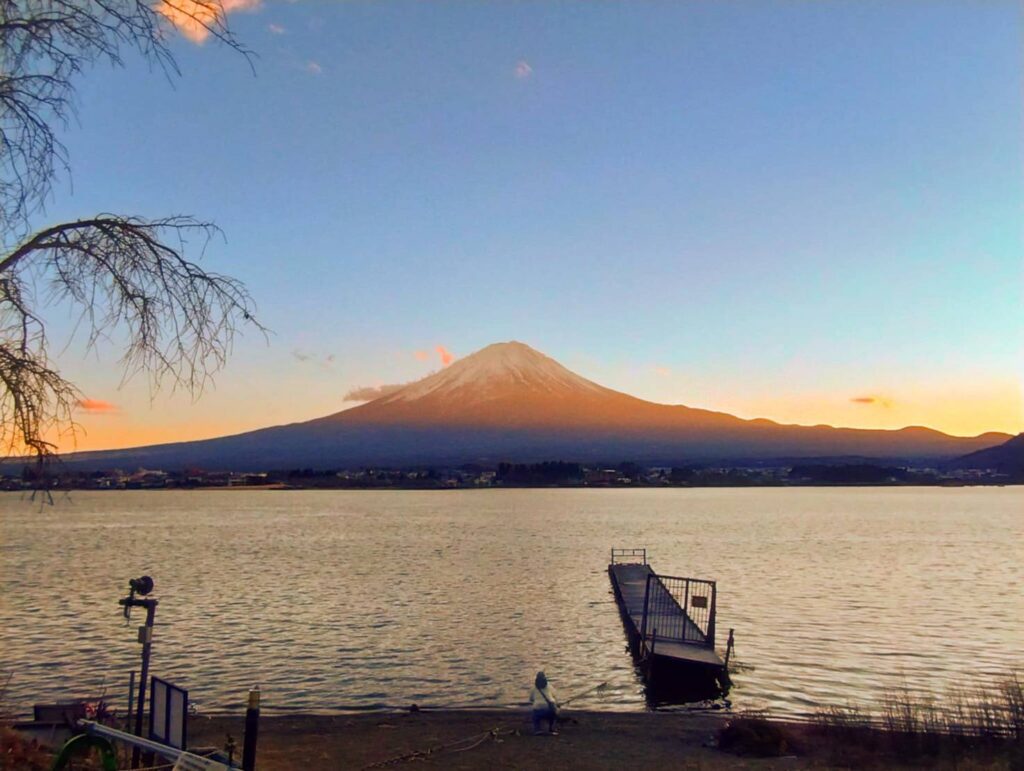Quick Navigation
- 1 Introduction
- 2 What Mt. Fuji Looks Like in Each Season
- 3 When to Visit Mt. Fuji Depending on What You Want to Do
- 4 Spring – Cherry Blossoms & New Life
- 5 Summer – Blue Skies & Mountain Adventures
- 6 Autumn – Colorful Leaves & Crisp Air
- 7 Winter – Snow-Capped Majesty
- 8 Conclusion – When Should You Visit Mt. Fuji?
Introduction
As a local living in Kawaguchiko, I know the Fuji Five Lakes area inside out.
Let me share some hidden spots where you can quietly enjoy Mt. Fuji—places you won’t find in the guidebooks—while discovering the true charm of Japan.
Japan is a country with four distinct seasons: spring, summer, autumn, and winter. Each season offers its own unique charm, colors, and experiences. From the way you enjoy nature and the local culture, to the seasonal foods and even how Mt. Fuji appears, everything changes dramatically depending on when you visit.
From cherry blossoms in spring to a snow-capped peak in winter, Mt. Fuji shows a different face with every season. In this article, I’ll guide you through the beauty of Mt. Fuji throughout the year, so you can experience this iconic mountain at the perfect time for you.
Whether you’re looking for a peaceful moment, a cultural discovery, or that perfect landscape photo, every season holds something truly special.
What Mt. Fuji Looks Like in Each Season
Mt. Fuji isn’t just one view — it changes dramatically with the seasons, and each one has its own charm.
- Spring (March–May):
Clear skies and cherry blossoms make spring a favorite for photographers.
Late April to early May is especially beautiful when you can catch pink flowers in the foreground with snow still on the mountain peak. - Summer (June–August):
Mt. Fuji opens for climbing, but the mountain is often covered in clouds during the day.
Early mornings or late evenings offer your best chance for a clear view. - Autumn (September–November):
Fall brings cool, dry air and vibrant red and yellow leaves around the base of the mountain.
Visibility is generally good, especially in October and November. - Winter (December–February):
This is the clearest season to see Mt. Fuji — and the most iconic, with a perfect snow-covered peak.
Cold temperatures mean crisp skies and some of the most photogenic views all year.
If you’re flexible with your schedule, planning around the seasons can totally change how you experience Mt. Fuji.
When to Visit Mt. Fuji Depending on What You Want to Do
There’s no single “best time” for everyone — it really depends on what kind of trip you’re planning.
- Want to climb Mt. Fuji?
→ Come in summer (early July to early September), when the trails are officially open.
You can’t climb Mt. Fuji year-round — the climbing season is limited to specific months.
If you don’t have proper gear, such as hiking boots and appropriate clothing, you may even be stopped at the gate before entering.
For beginners, climbing Mt. Fuji can be a physically demanding challenge.
If you plan to take it on, make sure you’re well-prepared before starting your climb!
- Want to take photos of the snow-capped mountain?
→ Visit in winter or early spring, when visibility is best and the summit is beautifully white.
In winter, Mt. Fuji is capped with snow, creating a beautiful, picture-perfect scene — a true symbol of Japan.
Around the Fuji Five Lakes, especially Lake Kawaguchiko and Lake Yamanakako, there are plenty of great spots to capture stunning views of the mountain.
If you want to discover hidden photo spots that only locals know about, check out this article!
👉Lake Kawaguchiko: A Local’s Guide to Hidden Spots and the Best Mt. Fuji Views
- Interested in flowers, festivals, or mild hiking?
→ Late spring and autumn are perfect. You’ll find blooming flowers, colorful leaves, and pleasant weather.
If you’re looking to go hiking around Lake Kawaguchiko, check out this experience article!
The scenic route up Mt. Tenjo (also known as “Kachi Kachi Yama”) is absolutely refreshing — hike to the top and enjoy breathtaking views of Mt. Fuji.
The stunning panorama of Mt. Fuji and Lake Kawaguchiko from the summit makes every step of the hike worth it!
👉 Hike and Ride: Mt. Fuji Panoramic Ropeway & Tenjyozan Trail Experience at Kawaguchiko
- Looking to avoid crowds?
→ Try visiting early December or Late February— no school holidays, and great visibility if the weather’s clear.
If you’re planning to visit the Lake Kawaguchiko area during the quieter months from December to late February, be sure to explore all of the Fuji Five Lakes!
In addition to Kawaguchiko and Yamanakako, the lesser-known gems of Saiko, Shojiko, and Motosuko each have their own unique charm.
One highlight is the exact spot that inspired the Mt. Fuji scenery on the back of Japan’s 1,000 yen bill — a truly spectacular view you won’t want to miss!
👉 Model Course Near Mt. Fuji: Hike, Local Food, and a Scenic Lake Motosu Drive
👉 Exploring Iyashi no Sato Nenba: A Hidden Traditional Village Near Mt. Fuji
👉 Lake Shoji Travel Guide: The Most Peaceful Lake Near Mt. Fuji, Introduced by a Local
Knowing what you want to do helps you choose not just a season, but the perfect moment for your Fuji adventure.
Spring – Cherry Blossoms & New Life

Spring in Japan is a season of new beginnings. As the school year and business calendar start in April, the country comes alive with a fresh sense of renewal. But what truly makes spring special is the breathtaking beauty of cherry blossoms, or sakura.
When paired with the majestic presence of Mt. Fuji, the pink cherry blossoms create postcard-perfect views that attract visitors from all over the world. This is the season of hanami — the traditional custom of picnicking under the blooming trees with friends and family.
One of the most iconic spring spots is Chureito Pagoda in Fujiyoshida. Here, you can see the five-story pagoda framed by cherry blossoms, with Mt. Fuji standing tall in the background — a view so beautiful it feels like a dream.
Spring is the perfect time to experience Japan’s blend of natural beauty and cultural tradition. As the weather warms up, lakeside walks, cycling around Kawaguchiko, and trying seasonal foods like sakura mochi or sansai tempura make this a truly special time to visit.
Summer – Blue Skies & Mountain Adventures

Summer around Mt. Fuji is full of vibrant energy and outdoor fun. As the skies turn a deep blue and the mountain stands clearly visible in the warm sunshine, it’s the perfect time for nature lovers to explore the region.
This is the official climbing season for Mt. Fuji, usually from early July to early September. Hikers from all over the world come to conquer Japan’s highest peak and watch the sunrise from the summit — a truly unforgettable experience.
For those who prefer to stay at the base, summer is also ideal for camping, fishing, and cycling around lakes like Kawaguchiko and Yamanakako. I personally spent a night camping at Tsuhara Campground (Tsuhara Campground) by Lake Saiko, which turned out to be a hidden gem — quiet, peaceful, and with stunning views of nature.
If you want to discover a quiet, hidden campground that even most tourists don’t know about — a spot only locals are familiar with — check out this article!
👉 “Hidden Campground Near Mt. Fuji: My Peaceful Stay at Lake Saiko’s Tsuhara Campground”
If you’re up for a short drive, Numazu in nearby Shizuoka Prefecture is a popular coastal area just about an hour away by car. It’s a great spot for sea fishing, with the chance to catch seasonal fish like bonito (katsuo) or even squid (ika).
Shizuoka Prefecture is home to the sea and is famous for its fresh seafood. Traditional Japanese dishes like sushi and sashimi are especially popular here, attracting many Japanese travelers. One place you shouldn’t miss is Tosawaya, where the sashimi and fried horse mackerel are absolutely outstanding — a must-try at least once! It’s also known as a pilgrimage spot for fans of the Japanese anime Love Live!, making it a must-visit for anime enthusiasts as well.
👉 Seafood and Love Live! in Numazu: A Local Lunch Experience at Tosawaya Restaurant
Summer is also the season of traditional festivals and fireworks. Don’t miss the Lake Kawaguchi Fireworks Festival (Kawaguchiko Kojosai) or the Yamanakako Hoko Festival, where colorful fireworks light up the night sky with Mt. Fuji in the background.
Another cultural highlight is the Fujiyoshida Fire Festival (Yoshida no Himatsuri), held in late August. This dramatic event marks the end of the climbing season and features massive torches lining the streets — a powerful celebration of fire, nature, and spiritual tradition.
Whether you’re chasing adventure or soaking in summer vibes, Mt. Fuji in summer offers a perfect blend of excitement, nature, and culture.
Autumn – Colorful Leaves & Crisp Air

As summer fades into autumn, Mt. Fuji enters one of its most stunning seasons. The air becomes cool and crisp, the skies are clear, and vibrant red and golden leaves paint the landscape. It’s the perfect time for scenic walks and peaceful reflection.
The Momiji Corridor near Lake Kawaguchiko is one of the best spots to enjoy the autumn foliage, especially in November when the maple trees are at their peak. You’ll also find fields of golden pampas grass (susuki) swaying in the wind around places like Asagiri Highlands — a poetic sight unique to this season.
Autumn is also known as “the season of appetite” in Japan. This is the time to enjoy fresh seasonal produce like grilled sanma (Pacific saury), pears, chestnuts, and mushrooms. In Yamanashi, famous for its grapes, pears, and premium Shine Muscat, local vineyards open their doors for tastings and tours. Don’t miss the chance to try some Japanese wine from the Koshu region.
If you want to discover traditional Japanese dishes you should try when visiting Yamanashi, check out this article!
👉 What to Eat in Yamanashi famous food: 6 Local Foods You Must Try When Visiting Japan
For a modern twist, you might also see people celebrating Halloween, especially in big cities like Tokyo’s Shibuya, where costumes and parties fill the streets in late October. While it’s not a traditional Japanese event, it’s become surprisingly popular in recent years.
Whether you’re enjoying the fiery leaves, sipping wine by the lake, or warming up with seasonal dishes, autumn around Mt. Fuji offers a cozy, colorful escape from the crowds.
Winter – Snow-Capped Majesty

Winter brings a quiet, serene beauty to Mt. Fuji. The mountain is often covered in snow, creating the classic postcard view that many travelers dream of. The cold air is crisp and clean, making this one of the clearest seasons to see Mt. Fuji in all its glory.
Around the base of the mountain, lakes like Kawaguchiko and Yamanakako offer stunning reflections of the snow-capped peak. These areas are also great spots for winter activities, like ice fishing for wakasagi (Japanese smelt) — a local favorite in the Fuji Five Lakes region.
If you’re looking for more action, head to Fujiten Snow Resort, just a short drive from Kawaguchiko. It’s a fun and beginner-friendly ski area with views of Mt. Fuji right from the slopes — a unique winter experience you won’t find anywhere else.
Winter is also a season of warm traditions in Japan. Cozy up with a hot bowl of houtou, a local Yamanashi specialty made with thick noodles and seasonal vegetables. Or enjoy classic nabe (hot pot) dishes that bring friends and family together during the cold months.
The holiday season, from Christmas lights to New Year celebrations, adds a magical touch to the region. While Japan’s Christmas is more about lights and romance than religion, the New Year (Shogatsu) is the most important holiday of the year, filled with family gatherings, shrine visits, and traditional food.
For those seeking peace, beauty, and a deeper connection to the season, winter around Mt. Fuji is a truly special time.
Conclusion – When Should You Visit Mt. Fuji?
So, when is the best time to visit Mt. Fuji? It all depends on what you want to experience.
If your goal is to climb the mountain, summer (July to early September) is the only official season when trails are open and safe. For clear views and postcard-perfect photos, winter and early spring offer the most dramatic scenery, with Mt. Fuji beautifully covered in snow under bright skies.
If you’re looking for a balance of pleasant weather, vibrant colors, and fewer crowds, autumn might be your ideal time. And for those who want to enjoy Japan’s most iconic symbol surrounded by cherry blossoms, spring is truly magical.
Each season has its own charm, and no matter when you go, Mt. Fuji offers a unique and memorable experience. The key is to match the season to your travel style — whether you’re an adventurer, a photographer, or a slow traveler seeking peace and beauty.
No matter the time of year, Mt. Fuji is always worth the trip.
Want to enjoy Mt. Fuji in peace and away from the crowds?
Check out our guide to quiet places around Mt. Fuji:
👉 Lake Kawaguchiko Travel Tips: Where to Go, What to Eat, and Where to See Mt. Fuji


